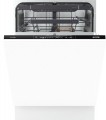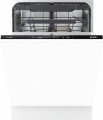Auto door opening
Auto door opening at the end of the programme. This function not only provides additional convenience, but also plays the role of a signal about the end of work; in addition, the open door helps to speed up drying — excess moisture escapes through it.
Inverter motor
The presence of
an inverter motor in the design of the dishwasher.
Inverter motors are brushless and have higher efficiency, lower noise levels, and improved safety due to the absence of brushes. However, they are more expensive compared to conventional motors.
Energy class
The energy efficiency class characterizes the the economy of a dishwasher's electricity consumption. Initially, the classes were denoted in Latin letters from A (high degree of economy) to G (high consumption). But later, with the development of energy saving technologies, more advanced classes than A appeared. They are denoted by the letter A with a certain number of pluses (
A+,
A++, etc.); the more benefits, the higher the economy. Most modern built-in dishwashers comply with energy classes from A to
A+++(the last is 30% more economical than the original class A). More high consumption models, such as classes B and C, are much rarer and gradually disappear.
More economical models cost more, but the difference can be recouped in energy savings. Also note that the energy consumption class does not describe efficiency in general, but in comparison with other similar models; therefore, the actual consumption of a small class A device may be lower than that of a large class A++ model.
Number of programmes
The number of washing programs (modes) provided in the dishwasher. These programs may differ in duration, exposure intensity, water temperature, dish material (for example for delicate dishes), etc. For more information on the different options, see "Washing programs". And the more modes — the more advanced the device is, the more options it provides to choose from. But note that with the same number of programs, their specific set in different models may be different; these details should be clarified separately.
Beam on floor
The light indicator of work of the dishwasher. During the operation of the device, a special light mark is projected onto the floor in front of it; at the end of the programme, this mark goes out. Thus, one glance in the direction of the device is enough to determine its current state. And for fully integrated models (see "Type of installation"), this function is also convenient because it is no need to open the door to check the status of the device. Actually, the vast majority of units
with a "beam on the floor" are fully integrated.
Also note that in high-end dishwashers, not just a light mark in the form of a dot can be used, but a miniature projector, which is a
beam on the floor with a time indication or with other auxiliary information.
Hot water supply
Possibility of connection of the dishwasher to a source of hot water. With this connection, the water enters the device already heated (unlike the usual procedure, when the dishwasher itself heats the water to the desired temperature) — thus it saves time and energy. However, note that
"hot connection" is demanding on the quality of water: in most cases, it must have a temperature of 60-65 °C and be supplied without pressure drops.
Note that hot water connection is an option, not the only way; dishwashers with the possibility of such a connection can usually work according to the standard scheme, from a source of cold water.

